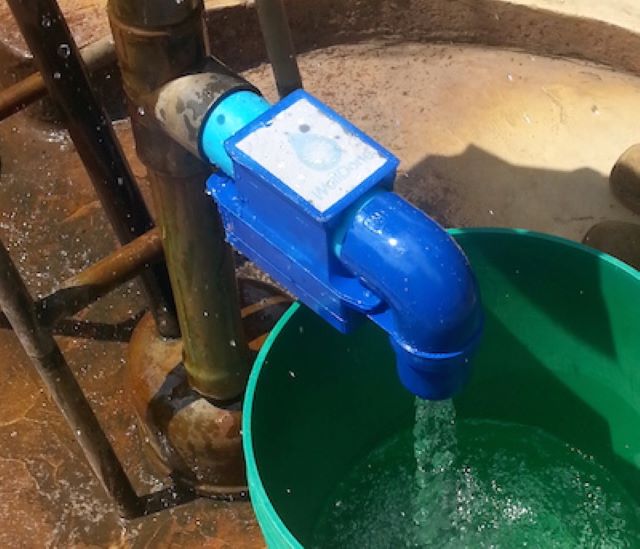Smart pump
This 3D printed prototype is an enclosure for a MoMo device that measures flow rate on a rope pump in rural Tanzania.
Contents |
[edit] Introduction
A smart pump is a pump that functions in a specific way under certain conditions. When connected through a network (as other devices operate by way of the Internet of Things) smart pumps communicate with each other and with those who operate them.
[edit] Basic smart pumps
Smart pumps can be used to prevent flooding. These devices are designed to respond to rising water conditions. When the water reaches a predetermined level, it completes a circuit. This causes the smart pump to operate. When the water level drops, the circuit is ‘broken’ and the pump stops.
In domestic applications, a smart sump pumping system is one that uses WiFi technology to send alert messages when flood conditions are possible. They can also relay messages about the condition of the pump if it malfunctions.
[edit] Telemetry
More advanced smart pumps use sensors or other Internet of Things (IoT) devices associated with telemetry to collect data. Telemetry is defined as data collection from remote points which is then automatically transmitted to monitoring equipment designed to receive the information. Because the data is collected automatically, technicians do not have to schedule visits to sites where the devices are operating unless it is physically necessary.
Some telemetry devices on smart pumps can communicate through SMS messages to send operational updates from remote locations. This is a relatively low cost method of communication with a wide coverage range.
[edit] Energy efficiency
Smart pumps can be used to optimise energy consumption and minimise pump lifecycle costs through reduced maintenance. These devices typically use pumps that are driven by variable frequency drives (VFDs) and can gather information regarding operating performance. Possible benefits may include:
Additional reductions may be realised by increased process automation and efficiency.
One drawback to smart pumps may be the slow acceptance of site technicians in water and wastewater treatment facilities, to support smart pumps. This may be due to lack of familiarity with the devices or concerns over the additional maintenance that may be required.
[edit] Smart pumps for remote communities
In certain parts of the world, the delivery of clean water is a challenge. To address this problem, UNICEF is researching the feasibility of deploying remote sensors and mobile technology in ways that can help make pumps smarter and enable them to improve sustainable access to clean water.
Through the use of real-time data, it will be possible to issue alerts when pumps malfunction, allowing for quicker repairs and less down time for communities in need of water. The monitoring systems will also collect prognostic information that can be used to help anticipate failures based on patterns and historical data. This will allow technicians to repair devices proactively before problems occur.
Exploratory projects include:
- SweetSense programme (developed with support from Portland State University). This sensor technology monitors performance of infrastructure including sanitation and water projects.
- Smart Handpumps (University of Oxford). These devices use a mobile data transmitter and an accelerometer linked to the pump handle to gather hourly pump usage data.
- MoMo mobile monitors (WellDone). This approach uses GSM-enabled units attached to handpumps, pipes and power systems to collect and send data through SMS messages that can be monitored for usage levels associated with water and energy infrastructure.
- MANTIS (Leeds Beckett University and Environmental Monitoring Systems). Short for Monitoring and Analytics to Improve Service, Mantis is looking to develop telemetry tools for post-construction monitoring of remote water points in developing regions.
[edit] Related articles on Designing Buildings Wiki
- Global smart water management.
- Internet of things IoT.
- Sump pump.
- Sustainable water management.
- Switch.
- Water engineering.
[edit] External resources
Featured articles and news
RTPI leader to become new CIOB Chief Executive Officer
Dr Victoria Hills MRTPI, FICE to take over after Caroline Gumble’s departure.
Social and affordable housing, a long term plan for delivery
The “Delivering a Decade of Renewal for Social and Affordable Housing” strategy sets out future path.
A change to adoptive architecture
Effects of global weather warming on architectural detailing, material choice and human interaction.
The proposed publicly owned and backed subsidiary of Homes England, to facilitate new homes.
How big is the problem and what can we do to mitigate the effects?
Overheating guidance and tools for building designers
A number of cool guides to help with the heat.
The UK's Modern Industrial Strategy: A 10 year plan
Previous consultation criticism, current key elements and general support with some persisting reservations.
Building Safety Regulator reforms
New roles, new staff and a new fast track service pave the way for a single construction regulator.
Architectural Technologist CPDs and Communications
CIAT CPD… and how you can do it!
Cooling centres and cool spaces
Managing extreme heat in cities by directing the public to places for heat stress relief and water sources.
Winter gardens: A brief history and warm variations
Extending the season with glass in different forms and terms.
Restoring Great Yarmouth's Winter Gardens
Transforming one of the least sustainable constructions imaginable.
Construction Skills Mission Board launch sector drive
Newly formed government and industry collaboration set strategy for recruiting an additional 100,000 construction workers a year.
New Architects Code comes into effect in September 2025
ARB Architects Code of Conduct and Practice available with ongoing consultation regarding guidance.
Welsh Skills Body (Medr) launches ambitious plan
The new skills body brings together funding and regulation of tertiary education and research for the devolved nation.
Paul Gandy FCIOB announced as next CIOB President
Former Tilbury Douglas CEO takes helm.
UK Infrastructure: A 10 Year Strategy. In brief with reactions
With the National Infrastructure and Service Transformation Authority (NISTA).
























Comments